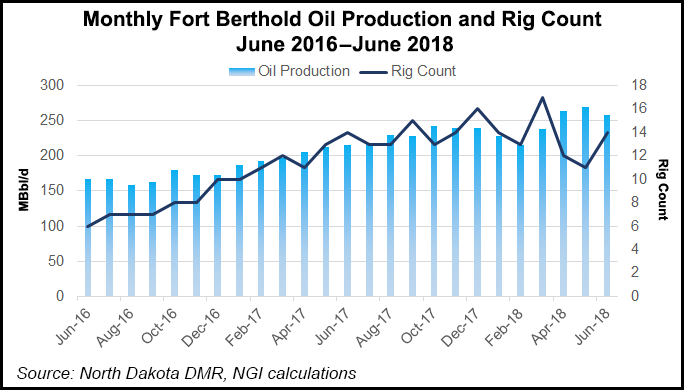Bakken Shale | E&P | NGI All News Access | NGI The Weekly Gas Market Report
Bakken’s Fort Berthold Output Down on Natural Gas Capture Issues
North Dakota’s most recent production reports indicated that more than half of the 21,000 b/d decrease in crude oil production between May and June was on Fort Berthold Reservation lands, which account for roughly 25% of the Bakken Shale’s production in any given month.

As operators tried to de-emphasize operations where they have the most problems with gas capture, they scaled back production on Fort Berthold, resulting in an 11,000 b/d production reduction in June, according to the Department of Mineral Resources (DMR).
“Industry is very sensitive toward gas capture goals, and Fort Berthold is the most problematic area in terms of gas capture,” said DMR Director Lynn Helms during a recent webinar in discussing monthly statistics for June.
“The gas capture policy seems to be working very well,” he said. “There is a ton of communication taking place between gas operators and the gatherers and processors.”
Fort Berthold had 37 uncompleted wells in June, more than half of the state-wide total of 75. Its share of Bakken oil production was 258,378 b/d with 14 rigs operating, including two on fee lands and 12 on trust lands.
The issue of rights-of-way (ROW), considered a key component to build gathering and processing capacity, “really comes to a head on tribal lands like Fort Berthold,” Helms said. “One of the gathering companies indicated it took 455 days to get a permit, so there are discussions with the Department of Interior to find ways to address this to create ROWs that are more flexible in the future…The Bureau of Indian Affairs officials have taken the most conservative interpretations they could of current ROWs.”
Helms cited an example where a gathering company built two pipelines within an existing ROW designated for three pipelines, but it delayed the third line. When it came back to add the third pipeline, the company had to create a new ROW and it waited more than a year for a permit.
“Those are the types of issues being worked on to see how existing ROWs can be interpreted differently to make it easier to expand capacity, and how should new ROWs be written in a way that they have more flexibility,” Helms said. He added it always is a longer process on federal lands but the average is six to nine months.
“It’s about half the time that it’s been taking on federal lands on Fort Berthold,” he said.
© 2024 Natural Gas Intelligence. All rights reserved.
ISSN © 2577-9877 | ISSN © 1532-1266 | ISSN © 2158-8023 |
